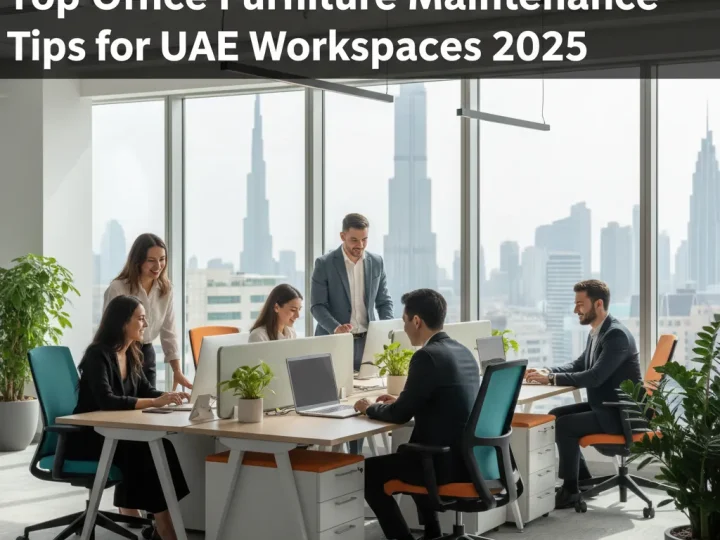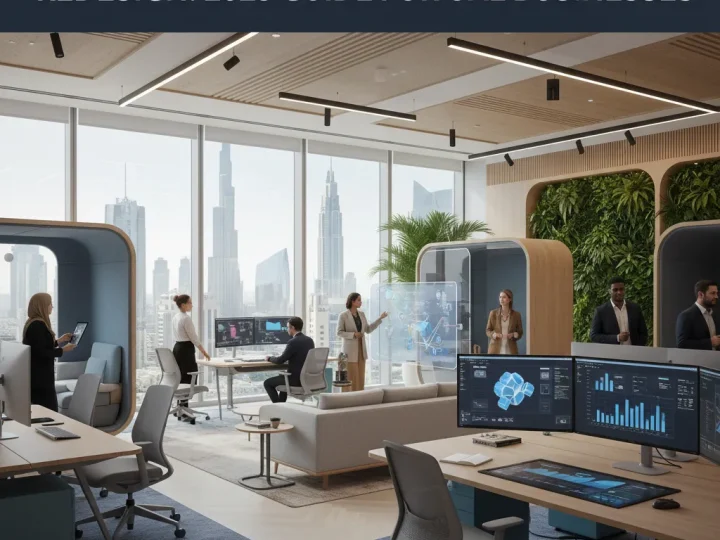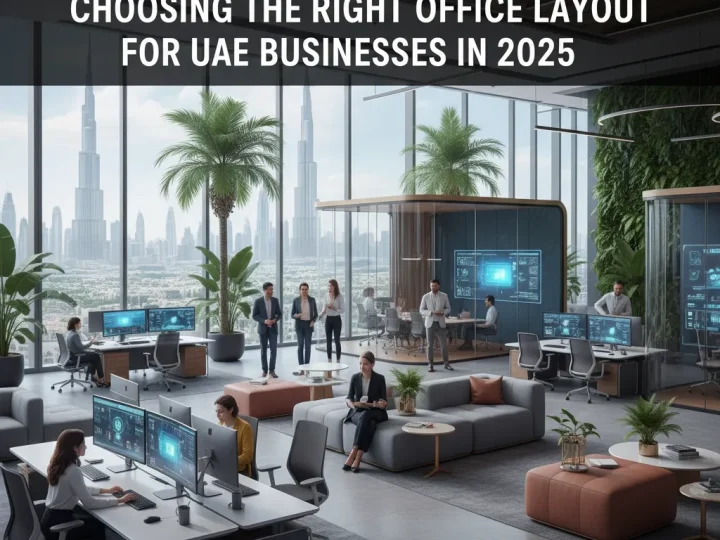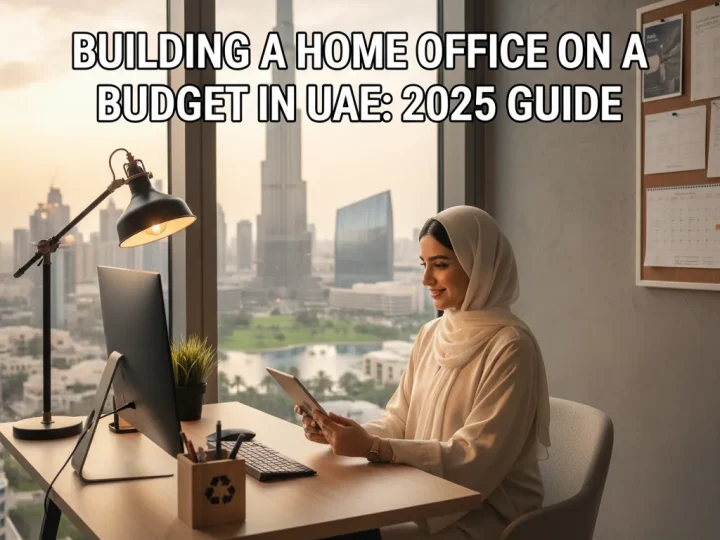

Workplace design is undergoing a revolution—modern offices are now crucial for employee wellbeing, collaboration, and productivity. But wait—despite all the buzz, many companies still cling to outdated layouts that actually hinder performance. The unexpected truth is that success isn’t just about flashy designs; it’s about creating flexible, human-centered spaces that empower workers. This shift is transforming how we think about work environments in ways that can significantly enhance both satisfaction and results.
Modern Workspace Layouts
Workplace design has evolved dramatically in recent years, moving beyond simple functionality to encompass employee wellbeing, collaboration, and flexibility. As organizations recognize the profound impact physical environments have on productivity and satisfaction, modern workspace layouts have become a critical component of business strategy rather than an afterthought.
Flexible Open Concepts vs. Private Spaces
The debate between open offices and private workspaces continues to shape contemporary office trends. While the completely open office dominated design thinking for years, research now supports a more nuanced approach. According to a study published in the International Journal of Environmental Research and Public Health, traditional cell offices showed the most positive outcomes for employee emotional health, while shared spaces affected different genders uniquely. The most successful modern layouts now incorporate both collaborative zones and quiet areas for focused work.
Progressive companies are implementing “neighborhood” designs—designated areas that support different work modes within the same office. These might include:
- Activity-based workspaces that allow employees to choose environments based on their current task
- Focus pods for high-concentration work requiring minimal distraction
- Collaborative hubs equipped with technology for team ideation and problem-solving
The key insight driving these layouts is that no single configuration meets all needs. Instead, variety and choice have become central to effective workspace design.

Biophilic Elements and Natural Integration
Modern workspace layouts increasingly incorporate biophilic design—the integration of nature into built environments. This approach goes beyond simply adding a few plants; it encompasses natural light, organic materials, living walls, and views of outdoor spaces.
The benefits of biophilic design are substantial. Natural elements reduce stress, improve cognitive function, and enhance creativity. Companies like Amazon have taken this concept to extraordinary levels with their Spheres headquarters in Seattle, featuring over 40,000 plants from around the world. While not every organization can build botanical gardens, even modest implementations of natural elements can transform sterile office environments into vibrant, restorative spaces.
Modern workspace layouts that successfully incorporate biophilic elements tend to feature larger windows, fewer interior walls, and strategic placement of workstations to maximize natural light exposure. Materials like wood, stone, and other organic textures create warmth and visual interest while reinforcing the connection to nature.
Technology-Enabled Adaptability
The most innovative contemporary office trends embrace adaptability through technology integration. Smart office systems now allow spaces to transform based on occupancy patterns, time of day, or specific activities. Meeting rooms equipped with modular furniture and integrated technology can shift from traditional conference setups to workshop configurations within minutes.
This adaptability extends to individual workstations as well. Height-adjustable desks, mobile partitions, and reconfigurable furniture empower employees to customize their immediate environment. The result is a workspace that responds to people rather than forcing adaptation in the opposite direction.
As hybrid work models become standard, office layouts must support seamless transitions between remote and in-person collaboration. This has accelerated the adoption of high-quality video conferencing facilities, digital whiteboards, and ambient technology that enables equal participation regardless of physical location.
The most successful modern workspace layouts avoid rigid designations in favor of fluid, purpose-driven environments that can evolve alongside changing work patterns. By combining thoughtful design with employee choice and technological support, organizations create spaces that truly enhance the work experience rather than merely containing it.

Key Takeaways
| Takeaway | Explanation |
|---|---|
| Flexible Configurations | Successful modern office layouts blend open and private spaces to support diverse work needs, emphasizing variety and choice. |
| Biophilic Design Benefits | Incorporating natural elements like light and plants in workspace design improves employee wellbeing, cognitive function, and creativity. |
| Smart Technology Integration | Utilizing IoT and smart systems enhances adaptability in office environments, allowing spaces to adjust to real-time needs and promoting hybrid work effectiveness. |
| Focus on Sustainability | Emphasizing sustainable materials, energy efficiency, and integrated wellbeing initiatives positions organizations as responsible and attractive to talent. |
| Inclusive Workplace Culture | Fostering an inclusive and equitable environment ensures diverse perspectives are valued, aligning workplace culture with employee expectations and organizational values. |
Smart Office Technology
The digital transformation of workplaces has accelerated dramatically, with smart office technology becoming a cornerstone of contemporary office trends. Today’s intelligent workspaces leverage interconnected systems and data analytics to enhance efficiency, comfort, and collaboration in ways that were unimaginable just a decade ago.
IoT Integration and Workplace Analytics
The Internet of Things (IoT) has revolutionized how office spaces function and how organizations understand workplace utilization. Smart sensors deployed throughout office environments continuously collect data on occupancy, temperature, lighting levels, and air quality. This wealth of information drives both immediate adjustments and long-term strategic planning.
According to research from Colliers International and Schneider Electric, implementing pervasive technologies in a “living lab” office setting significantly improves workplace efficiency through accurate monitoring of occupancy rates and optimized shared resource usage. These systems allow facility managers to identify underutilized areas, optimize cleaning schedules, and make data-driven decisions about space allocation.
The most sophisticated workplace analytics platforms go beyond simple occupancy tracking to analyze movement patterns, collaboration frequency, and even meeting effectiveness. This information helps organizations design spaces that support actual work behaviors rather than assumed needs. For companies embracing hybrid work models, these insights prove invaluable in determining how much space is truly required and how it should be configured.
Environmental Control Systems
Smart environmental systems represent one of the most immediately noticeable applications of intelligent office technology. Advanced HVAC controls, automated lighting, and dynamic window treatments work in concert to maintain optimal conditions while minimizing energy consumption.
These systems operate on multiple levels of intelligence:
- Responsive adjustments based on real-time occupancy and conditions
- Predictive algorithms that anticipate needs based on historical patterns
- User-controlled personalization through smartphone apps and desk controls
- Integration with calendar systems to prepare spaces before scheduled use
Beyond comfort, smart environmental controls significantly impact sustainability goals. Buildings equipped with intelligent systems typically reduce energy consumption by 20-30% compared to conventional buildings with static controls. As organizations face increasing pressure to reduce their carbon footprint, these technologies provide a pathway to meaningful improvements without sacrificing occupant comfort.
Collaboration and Productivity Tools
The third pillar of smart office technology focuses on enhancing how people work together, regardless of physical location. Digital collaboration tools have evolved from simple video conferencing to comprehensive platforms that create seamless experiences across physical and virtual environments.
Meeting rooms equipped with smart technology automatically recognize participants, adjust settings based on meeting type, and capture notes and action items. Digital whiteboards synchronize content between in-room displays and remote participants, ensuring equal participation. Voice assistants streamline administrative tasks, from booking rooms to ordering supplies.
The integration of these technologies creates what some experts call “ambient intelligence” – an environment that anticipates needs, responds intuitively, and fades into the background rather than demanding attention. This ambient quality represents the highest evolution of smart office technology, where the tools become nearly invisible while their benefits remain prominently felt.
As organizations navigate the complexities of hybrid and flexible work arrangements, smart office technology will continue to play a crucial role in creating environments that support diverse work styles. The most successful implementations will be those that balance technological capability with human-centered design, ensuring that innovation serves people rather than the other way around.
While the proliferation of workplace technology presents exciting possibilities, it also raises important questions about privacy, data security, and technology dependence. Forward-thinking organizations are developing clear policies around data collection and usage, ensuring transparency and maintaining employee trust as these systems become more pervasive.
Sustainable Design Solutions
Sustainability has evolved from a niche consideration to a central pillar of contemporary office trends. Today’s workspaces must not only support productive work but also reflect organizational values and commitments to environmental stewardship. Sustainable design solutions address this dual mandate through thoughtful material selection, energy-efficient systems, and holistic approaches to the office ecosystem.
Materials and Circular Economy Principles
The sustainable office begins with responsible material choices. Forward-thinking organizations are moving beyond conventional materials to embrace alternatives with lower environmental impacts. Rapidly renewable resources like bamboo have gained popularity for furniture and finishes due to their quick regeneration cycles and versatility.
According to research on Design for Sustainability (D4S), bamboo offers significant advantages as a sustainable material for office furnishings. Unlike traditional hardwoods that may take decades to mature, bamboo regenerates quickly while providing comparable durability and aesthetic appeal. This makes it an ideal candidate for furniture pieces that embody sustainability without compromising on quality or design.
Beyond material selection, circular economy principles have begun reshaping office procurement and disposal practices. This approach emphasizes:
- Product longevity through durable, repairable designs
- Modular components that can be easily upgraded or reconfigured
- End-of-life reclamation systems that recover materials for reuse
- Leasing models that shift responsibility for product lifecycle to manufacturers
Companies like Steelcase and Herman Miller have pioneered take-back programs that ensure office furniture remains in productive use or is properly recycled rather than sent to landfills. These initiatives represent a fundamental shift from linear consumption patterns to circular systems that minimize waste and maximize resource value.
Energy Efficiency and Carbon Neutrality
Sustainable office design extends well beyond material considerations to encompass energy systems and operational efficiency. The most progressive workspaces aim for net-zero or even net-positive energy status, producing as much or more energy than they consume.
This transformation begins with passive design strategies that reduce energy demands. Strategic orientation, optimal window placement, and effective insulation minimize heating and cooling requirements before mechanical systems are ever engaged. When active systems are necessary, high-efficiency equipment, smart controls, and renewable energy sources further reduce environmental impact.
Renewable energy integration has become increasingly feasible for office environments. On-site solar installations, participation in community solar projects, and green power purchasing agreements allow organizations of all sizes to transition away from fossil fuel dependency. Companies like Adobe and Microsoft have gone further by committing to carbon-negative operations, removing more carbon from the atmosphere than they emit.
These commitments extend to daily operations as well. Motion-activated lighting, daylight harvesting systems, and energy-efficient equipment substantially reduce consumption. When combined with employee engagement programs that encourage conservation behaviors, these measures can reduce energy use by 30-50% compared to conventional offices.
Human-Centered Sustainability
Perhaps the most significant evolution in sustainable office design is the recognition that environmental considerations and human wellbeing are inherently connected. The most effective sustainable workspaces address both ecological impacts and human needs, creating environments that nurture occupants while treading lightly on the planet.
This holistic approach manifests in several ways:
- Indoor air quality measures that eliminate toxins and maintain optimal ventilation
- Access to daylight and views that connect occupants with natural cycles
- Thermal comfort systems that minimize energy use while maximizing individual control
- Water conservation through efficient fixtures and possibly on-site treatment systems
Companies pursuing certification under standards like WELL Building or LEED demonstrate commitment to this integrated vision of sustainability. These frameworks evaluate not only environmental performance but also how spaces support human health, comfort, and productivity.
The business case for sustainable design has strengthened considerably as evidence mounts for its positive impacts on recruitment, retention, productivity, and brand perception. What was once viewed as a costly obligation has become a strategic advantage, with sustainable workspaces delivering measurable benefits to both balance sheets and employee experience.
As organizations face increasing pressure to address climate change and environmental degradation, sustainable office design provides a tangible way to align operations with larger corporate social responsibility goals. The most effective approaches treat sustainability not as a separate initiative but as an integral part of workplace strategy, woven throughout decisions from site selection to daily operations.
Flexible Work Environment Ideas
The concept of workplace flexibility has evolved dramatically, becoming one of the most significant contemporary office trends shaping modern work environments. Beyond simply allowing remote work, today’s flexible workspaces incorporate multiple dimensions of adaptability to accommodate diverse work styles, personal needs, and business requirements.
Hybrid Work Models and Infrastructure
Hybrid work arrangements have emerged as the dominant model for knowledge workers across industries. Rather than viewing the office as the default location, organizations now approach workspace as a spectrum of options. The most successful hybrid models avoid rigid formulas in favor of purpose-driven flexibility that aligns physical presence with specific activities and objectives.
Implementing effective hybrid work environments requires thoughtful infrastructure:
- Booking systems that allow employees to reserve desks, meeting rooms, and collaboration spaces in advance
- Consistent technology setups that provide equivalent experiences regardless of location
- Communication protocols that ensure information flows equally to remote and in-person team members
- Dedicated collaboration zones equipped for hybrid meetings and workshops
Companies like Spotify have pioneered a “work from anywhere” approach that empowers employees to choose their most productive environment while maintaining periodic in-person connections for team building and creative collaboration. This approach recognizes that different tasks benefit from different settings, allowing employees to match their environment to their work requirements.
Time Flexibility Beyond Location
True workplace flexibility extends beyond location to include temporal flexibility. Progressive organizations are moving away from rigid 9-to-5 schedules toward models that accommodate individual productivity patterns and personal responsibilities. This shift acknowledges that knowledge work is often measured by outcomes rather than hours logged.
Time flexibility manifests in several forms:
- Core hours policies that require availability during specific windows while allowing flexibility outside those times
- Compressed workweeks that redistribute standard hours across fewer days
- Results-based measurement that focuses on deliverables rather than time spent
- Flexible PTO policies that trust employees to manage their own time off
These approaches are particularly valuable for employees with caregiving responsibilities. Time flexibility allows parents, elder caregivers, and others to fulfill personal obligations without sacrificing professional opportunities. This inclusivity expands the available talent pool and promotes diversity across organizational levels.
Adaptable Physical Spaces
Within the physical office, flexibility means creating environments that can transform based on changing needs. Static floor plans with permanent assignments are giving way to dynamic spaces that serve multiple functions throughout the day or week.
Key elements of adaptable physical spaces include:
- Modular furniture systems that reconfigure easily for different activities
- Movable partitions that create temporary spaces for focused work or small group collaboration
- Multi-purpose rooms that transition from formal meetings to casual gatherings with minimal effort
- Technology integration that supports various configurations and use cases
Financial considerations often drive these adaptable designs, as organizations seek to maximize utility from expensive real estate. A conference room that sits empty 70% of the time represents significant wasted resources. By designing spaces to serve multiple functions, companies achieve better space utilization while providing more options to employees.
Personal Customization and Choice
The most advanced flexible work environments extend choice and control to individual employees. Rather than prescribing one-size-fits-all solutions, these workplaces provide options that allow personalization based on individual preferences and needs.
This approach includes:
- Varied seating options from traditional desks to lounge furniture
- Control over immediate environmental factors like lighting and temperature, where possible
- Freedom to modify spaces with personal items that enhance comfort and productivity
- Choice architecture that guides without mandating specific behaviors
Companies implementing these flexible environments report improved employee satisfaction and engagement. When workers feel empowered to create conditions that support their best work, they develop stronger connections to both their tasks and the organization.
The future of flexible work environments will likely involve even greater personalization through technology. Workspace apps that remember individual preferences, anticipate needs based on scheduled activities, and seamlessly integrate personal and professional tools represent the next frontier in workplace flexibility. As these technologies mature, the distinctions between home and office environments may continue to blur, creating truly friction-free transitions between work contexts.
Evolving Office Culture Trends
While physical design and technology form the backbone of contemporary office trends, the evolution of workplace culture represents perhaps the most profound transformation in modern work environments. As organizations compete for talent and seek to build resilient, innovative teams, cultural considerations have moved from background elements to strategic priorities that shape every aspect of the workplace experience.
Wellbeing-Centered Work Environments
Employee wellbeing has transitioned from a nice-to-have perk to a fundamental business imperative. Organizations increasingly recognize that sustainable performance depends on supporting the physical, mental, and emotional health of their workforce. This shift extends far beyond traditional wellness programs to encompass holistic approaches that address multiple dimensions of health.
According to research on key factors for sustainability, a supportive and inclusive corporate culture significantly enhances employee well-being, which in turn drives innovation, creativity, and long-term enterprise development. This virtuous cycle creates sustainable advantages that transcend short-term performance metrics.
Progressive organizations are implementing multifaceted wellbeing initiatives that include:
- Mental health resources ranging from meditation spaces to counseling benefits
- Ergonomic workstations that prevent physical strain and injury
- Healthy food options that fuel sustained energy and cognitive function
- Fitness facilities or subsidies that encourage regular physical activity
- Policies that discourage after-hours work communications
These initiatives reflect growing awareness that employee wellbeing directly impacts creativity, problem-solving capacity, and collaborative effectiveness. Rather than viewing these programs as peripheral benefits, forward-thinking companies integrate wellbeing considerations into core business strategies and workplace design decisions.
Inclusive and Equitable Environments
The drive toward greater workplace diversity has expanded to encompass genuine inclusion and equity. Organizations are moving beyond demographic representation to create environments where all employees can participate fully, access opportunities equitably, and feel valued for their unique perspectives and contributions.
This cultural evolution manifests in both policy changes and physical design considerations:
- Universal design principles that accommodate diverse physical abilities
- Private spaces for religious observance, nursing mothers, and neurodivergent employees seeking reduced stimulation
- Technology solutions that level the playing field for remote and in-office workers
- Meeting protocols that ensure all voices are heard regardless of status or communication style
The most successful inclusive cultures embed equity considerations into decision-making processes rather than treating diversity as a separate initiative. This integration ensures that inclusion becomes part of organizational DNA rather than a compliance exercise or temporary focus area.
Purpose and Values Alignment
Modern workers increasingly seek purpose and meaning in their professional lives, expecting alignment between personal values and organizational mission. This trend has accelerated as younger generations enter the workforce with expectations of employment that contributes to social good beyond profit generation.
Companies are responding by articulating clear purpose statements, demonstrating authentic commitment to stated values, and creating opportunities for employees to connect their individual work to broader impact. These efforts include:
- Transparent communication about organizational goals and societal contributions
- Service days or paid volunteer time that allows employees to support causes they value
- Internal initiatives that address environmental or social challenges
- Physical spaces that visually reinforce mission and values
These purpose-oriented approaches foster deeper employee engagement and strengthen organizational resilience during challenging periods. When team members understand how their work contributes to meaningful outcomes, they display greater perseverance, creativity, and collaborative spirit.
Democratized Decision Making
Hierarchical leadership models are giving way to more distributed approaches that incorporate diverse perspectives into decision-making processes. This trend reflects both changing workforce expectations and recognition that complex problems benefit from multiple viewpoints.
Organizations are implementing various mechanisms to democratize workplace decisions:
- Cross-functional teams with the authority to implement solutions without multiple approval layers
- Transparent sharing of information previously restricted to management levels
- Regular feedback channels that capture employee insights about workplace functioning
- Participatory processes for meaningful decisions about office design and policies
These approaches recognize that those closest to the work often have the most valuable insights about improvement opportunities. By creating channels for these insights to influence decisions, organizations tap into collective intelligence while building cultures of ownership and accountability.
The future of office culture will likely continue this trend toward greater humanity and authenticity in workplace relationships. As artificial intelligence automates routine tasks, distinctly human qualities like empathy, creativity, and ethical judgment become increasingly valuable. Organizations that create cultures celebrating these qualities position themselves advantageously for the evolving nature of knowledge work.
Frequently Asked Questions
What are the key contemporary office trends?
Modern office trends focus on flexible workspace designs, biophilic elements, smart technology integration, sustainable solutions, and fostering inclusive workplace cultures.
How can biophilic design improve office environments?
Biophilic design incorporates natural elements into office spaces, which can reduce stress, boost creativity, and improve cognitive function by connecting employees with nature.
What is the importance of flexible workspace layouts?
Flexible workspace layouts cater to diverse work styles by combining open areas for collaboration with private spaces for focused tasks, enhancing overall employee satisfaction and productivity.
How does smart technology enhance office productivity?
Smart technology increases productivity by enabling adaptable environments, optimizing energy efficiency, and facilitating seamless communication and collaboration through connected devices.
Transform Your Office with SAGTCO’s Innovative Solutions
In today’s rapidly evolving workspace, flexibility and adaptability are more critical than ever. As highlighted in Contemporary Office Trends, the blurred lines between open and private spaces can create environments that foster collaboration while enhancing focused work. But how do you actualize this vision? This is where SAGTCO can help!

At SAGTCO, we understand that your workspace should resonate with your company’s values and empower your team. Our extensive catalog features customizable office furniture, smart interactive digital systems, and expert space planning consultations tailored to meet your unique needs. Whether you’re aiming for biophilic elements to improve air quality or technology-enabled adaptability for hybrid work models, we’ve got you covered.
Don’t let outdated designs limit your productivity! Act now to create a workspace that inspires creativity and drives results. Visit us at https://sagtco.com and discover how our solutions can transform your office into a thriving environment. Contact us today for a free consultation and take the first step towards an innovative, efficient, and vibrant workspace!




